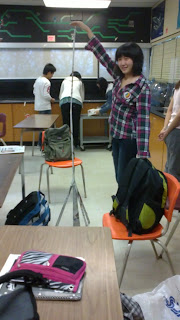Results
The following graphs show the relationship between position in meters (m) and time in seconds (s) with time as the independent variable (Graph 1 & 2).
Graph 1
Graph 1 shows the displacement over 10 seconds for the above graph. It can be derived from Graph 1 that the object stays still 1 meter away from the origin for 1 second. Then it moves at a constant velocity for 2 seconds until it is 2.5 meters away from the origin and stops 2.5 meters away from the origin for 3 seconds. After, the object moves 1 meter toward the origin at a constant velocity for approximately 1.5 seconds, and the object stops 1.75 meters away from the origin for 2.5 seconds.
Graph 2 shows the displacement over 10 seconds for the above graph. It can be derived from Graph 2 that the object moves 1.5 meters toward the origin at a constant velocity for 3 seconds and then stops 1.5 meters away from the origin, for 1 second. Then, the object moves 1 meter toward the origin at a contant velocity for 1 second and stops 0.5 meters away from the origin for 2 seconds. After, the object moves 2.5 meters away from the origin at a constant velocity for 2.5 seconds.
It can be derived from Graph 3 that the object starts off 0.9 meters away from the origin and proceeds to move 0.9 meters away from the origin at a constant velocity for 2.7 seconds. Then, the object stops and remains 1.8 meters away from the origin for 2.6 seconds. After, the object moves 1.5 meters away from the origin for 2.7 seconds.
The following graphs display the relationship between velocity (in meters (m)/seconds (s)) and time in seconds (s).
Graph 4 starts off with a velocity of 0, indicating at 0 seconds, the object is at a halt in front of the motion detector and continues to remain stopped for 2 seconds. By 2 second, the velocity suddenly shifts to 0.5m/s over the span of 3 seconds, indicating the object is moving away from the origin at a constant velocity of 0.5m/s. Then, the object quickly stops in 0.1 seconds and remains still for 2 seconds until it suddenly starts moving again towards the origin at a constant velocity of 0.5m/s, due to the line extending into the negative quadrant.
Graph 5 begins with a velocity of 0m/s with the object moving increasing faster and further away from the origin for 4 seconds, reaching a peak of 0.5m/s. At 4 seconds, the object moves at a constant velocity of 0.5m/s for 2 seconds before it suddenly moves toward the origin at a constant velocity of 0.4m/s for 9s and then stops for 1 second.







































